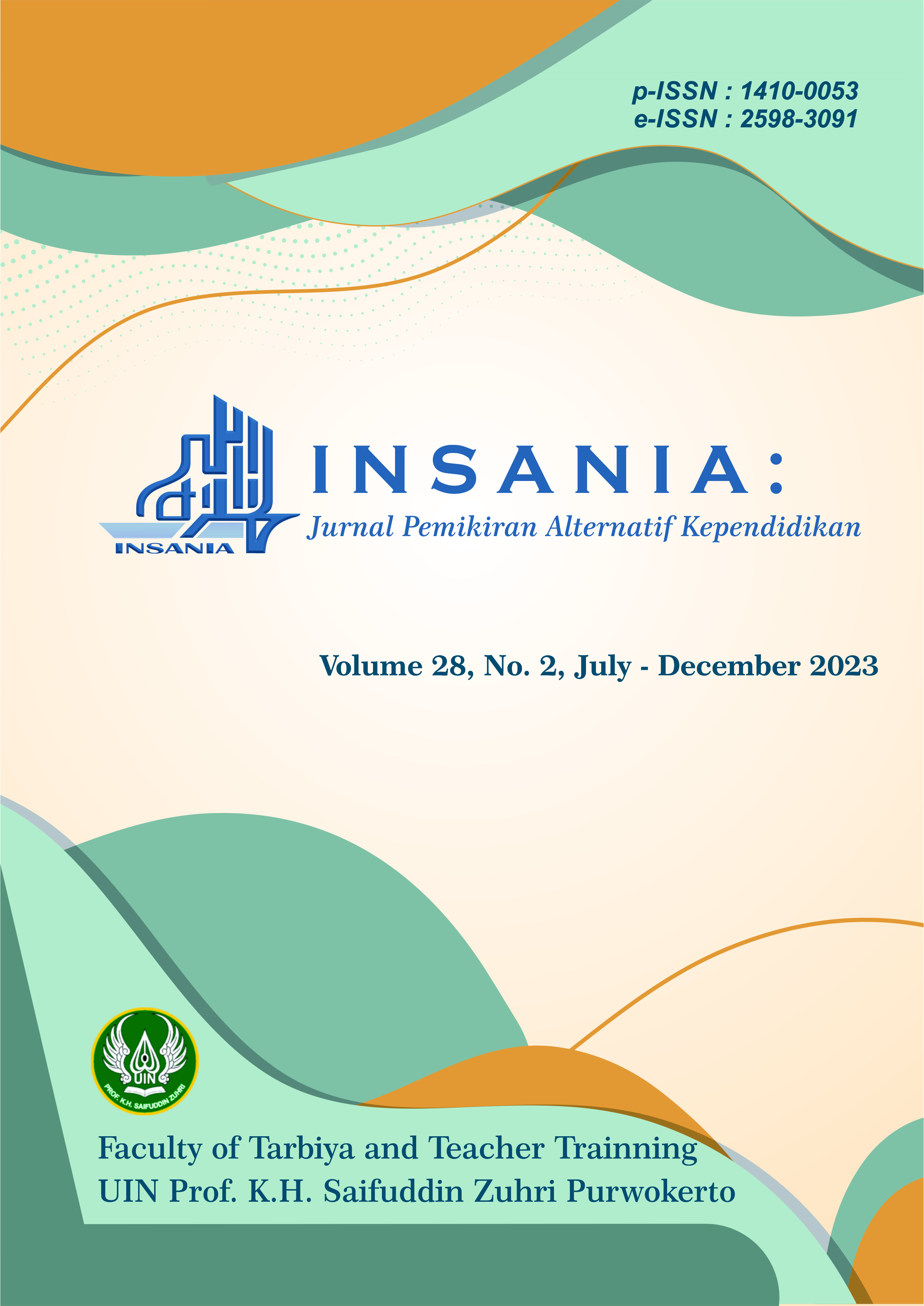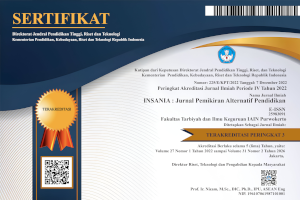The Effectiveness of mobile learning media using Smart Apps Creator on Economic subjects
DOI:
https://doi.org/10.24090/insania.v28i2.8347Keywords:
development, media, mobile learning, Smart Apps CreatorAbstract
This study aims to produce mobile learning media using the Smart Apps Creator and to determine the effectiveness of these media in increasing student interest in learning. The 4D model (Define, Design, Develop, and Disseminate) is used in the research and development process for this project. This research is limited to the development phase. The participants in this research were XI IPS SMA PGRI Pekanbaru students. Data was obtained based on interviews and questionnaires. Based on the substantiation of media and content specialists, the research findings indicate that the use of mobile learning media created by smart apps creator is feasible, with 87% of the categories being very appropriate according to media experts and 83% of the categories being very appropriate based on subject matter experts. Paired sample t-test obtained differences and positive increases in student learning interest before and after using smart apps creator-based mobile learning media, so the media is said to be effective. The use of media received a good response from students; 64.5% consider mobile learning media using smart app creators to be very practical and helpful in learning, while the remaining 35.5% consider it practical. This research is limited to APBN and APBD material and is only carried out until the development stage.Downloads
References
Ardiansyah, A. A., & Nana, N. (2020). Peran Mobile Learning sebagai Inovasi dalam Meningkatkan Hasil Belajar Siswa pada Pembelajaran di Sekolah. Indonesian Journal Of Educational Research and Review, 3(1), 47–56. https://doi.org/10.23887/ijerr.v3i1.24245
Aripin, I. (2018). Konsep dan Aplikasi Mobile Learning dalam Pembelajaran Biologi. Bio Educatio (The Journal of Science and Biology Education), 3(1), 1–9. http://dx.doi.org/10.31949/be.v3i1.853
Astari, D., Maulina, J., & Ariyanti, L. (2018). Pengembangan Multimedia Menggunakan Pendekatan Saintifik Pada Materi Larutan Elektrolit dan Non Elektrolit Multimedia. Journal of Chemistry, Education, and Science, 2(2), 11–21. https://doi.org/10.30743/cheds.v2i2.1011
Aziz, A. F., & Suparman, S. (2015). Pengembangan Media Pembelajaran Berbasis Adobe Flash Untuk Meningkatkan Minat Belajar Siswa Pada Mata Pelajaran Mekanika Teknik Jurusan Teknik Gambar Bangunan di SMK N 1 Seyegen. Jurnal Elektronik Mahasiswa Pendidikan Teknik Sipil, 3(5), 1–9. https://journal.student.uny.ac.id/ojs/index.php/sipil/article/view/4464
Azizah, A. R. (2020). Penggunaan Smart Apps Creator (SAC) untuk mengajarkan global warming. Prosiding Seminar Nasional Fisika (SNF) Unesa, 4(2), 72–80. https://fisika.fmipa.unesa.ac.id/proceedings/index.php/snf/article/view/143
Dan, Y., & Todd, R. (2014). Examining the mediating effect of learning strategies on the relationship between students’ history interest and achievement. Educational Psychology, 34(7), 799–817. https://doi.org/10.1080/01443410.2013.792331
Emalia, E., & Farida, F. (2019). Inovasi Pendidikan dengan Memanfaatkan Teknologi Digital dalam Upaya Menyonsong Era Revolusi Industri 4.0. Prosiding Seminar Nasional Pendidikan Program Pascasarjana Universitas PGRI Palembang, 160–169. https://jurnal.univpgri-palembang.ac.id/index.php/Prosidingpps/article/view/2984/0
Ernawati, Y. (2016). Deskripsi Kemampuan Penalaran Matematis Dan Minat Belajar Siswa Kelas Viii Smp Negeri 9 Purwokerto. [Undergraduate Thesis, Universitas Muhammadiyah Purwokerto]. Repository Universitas Muhammadiyah Purwokerto. https://repository.ump.ac.id/1260/
Faqih, M. (2021). Efektivitas Penggunaan Media Pembelajaran Mobile Learning Berbasis Android Dalam Pembelajaran Puisi. Konfiks Jurnal Bahasa dan Sastra Indonesia, 7(2), 27–34. https://doi.org/10.26618/konfiks.v7i2.4556
Fitriyah, E. A., & Dewi, R. M. (2022). Pengembangan Media Interaktif Berbasis Android pada Mata Pelajaran Ekonomi. Jurnal Inovasi Pendidikan Ekonomi (JIPE), 12(1), 94–06. https://doi.org/10.24036/011167790
Friantini, R. N., & Winata, R. (2019). Analisis Minat Belajar pada Pembelajaran Matematika. JPMI (Jurnal Pendidikan Matematika Indonesia), 4(1), 6. https://doi.org/10.26737/jpmi.v4i1.870
Jamilah, Z. (2021). Pengembangan Media Pembelajaran Mobile Learning Pada Konsep Sistem Ekskresi. [Undergraduate Thesis, Universitas Islam Negeri Syarif Hidayatullah Jakarta]. Institutional Repository UIN Syarif Hidayatullah Jakarta. https://repository.uinjkt.ac.id/dspace/handle/123456789/56514
Karo-karo, I. R., & Rohani, R. (2018). Manfaat Media Dalam Pembelajaran. AXIOM: Jurnal Pendidikan Matematika, 7(1), 91–96. http://dx.doi.org/10.30821/axiom.v7i1.1778
Khairunnisa, S., Amirullah, G., & Ninawati, M. (2019). Development of Learning Android Media-Based Mobile Learning Applications in Courses Basic Concepts of Natural Sciences. Jurnal Inovasi Pendidikan Dasar, 4(2), 49–56. https://journal.uhamka.ac.id/index.php/jipd/article/view/8657
Lestari, K. I., Arcana, I. N., Susetyo, A. E., & Kuncoro, K. S. (2022). Development of Online Learning Quiz and Educational Game Using Word Walls in Mathematics for Grade 10. INSANIA : Jurnal Pemikiran Alternatif Kependidikan, 27(2), 145–159. https://doi.org/10.24090/insania.v27i2.6924
Milala, H. F., Endryansyah, Joko, & Agung, A. I. (2022). Keefektifan Dan Kepraktisan Media Pembelajaran Menggunakan Adobe Flash Player. Pendidikan Teknik Elektro, 11(1), 195–202. https://doi.org/10.26740/jpte.v11n02.p195-202
Nazmi, M. (2017). Penerapan Media Animasi untuk Meningkatkan Minat Belajar Peserta Didik pada Mata Pelajaran Geografi di SMA PGII 2 Bandung. Gea: Jurnal Geografi, 17(1), 48–57. https://doi.org/10.17509/gea.v17i1.6272.g4723
Ningsih, S. A., & Pritandhari, M. (2019). Pengembangan Media Pembelajaran Ludo Pada Mata Pelajaran Ekonomi Kelas Xi Sma Purnama Trimurjo. PROMOSI: Jurnal Program Studi Pendidikan Ekonomi, 7(1), 50–59. http://dx.doi.org/10.24127/pro.v7i1.2039
Nurrita, T. (2018). Pengembangan Media Pembelajaran Untuk Meningkatkan Hasil Belajar Siswa. MISYKAT: Jurnal Ilmu-Ilmu Al-Quran, Hadist, Syari’ah dan Tarbiyah, 3(1), 171–187. https://doi.org/10.33511/misykat.v3n1.171
Ofori, E., & Lockee, B. B. (2021). Next generation mobile learning: Leveraging message design considerations for learning and accessibility. IAFOR Journal of Education: Technology in Education, 9(4), 123–144. https://doi.org/10.22492/ije.9.4.07
Rasyid, F. R., Sudjarwo, & Trisnaningsih. (2017). Development Media Based Learning Flash Improve Student Learning Interest. Jurnal Studi Sosial, 5(2), 1–11. http://jurnal.fkip.unila.ac.id/index.php/JSS/article/view/13458
Riduwan. (2015). Skala pengukuran variabel-variabel penelitian. Alfabeta.
Samsinar, S. (2020). Mobile learning: Inovasi pembelajaran di masa pandemi COVID-19. Al-Gurfah : Journal of Primary Education, 1(1), 41–57. https://jurnal.iain-bone.ac.id/index.php/algurfah/article/view/372/
Sari, L. Y. (2016). Uji Efektivitas Media Pembelajaran Interaktif Berorientasi Konstruktivisme Pada Materi Neurulasi Untuk Perkuliahan Perkembangan Hewan. Bioconcetta, 2(1), 158–164. https://doi.org/10.22202/bc.2016.v2i1.1806
Serdyukov, P. (2017). Innovation in education: what works, what doesn’t, and what to do about it? Journal of Research in Innovative Teaching & Learning, 10(1), 4–33. https://doi.org/10.1108/jrit-10-2016-0007
Setiadi, M. E., & Ghofur, M. A. (2020). Pengembangan media pembelajaran mobile learning berbasis android dengan pendekatan kontekstual pada mata pelajaran ekonomi kelas X IPS. Didaktis: Jurnal Pendidikan Dan Ilmu Pengetahuan, 20(3), 291–307. http://dx.doi.org/10.30651/didaktis.v20i3.5187
Simanjuntak, S. F. (2019). Development of Interactive Multimedia Towards Economic Problems on Economic Subjects for Social Science Class X Students At Darma Yudha High School. International Journal of Educational Best Practices, 3(2), 64–74. https://doi.org/10.31258/ijebp.v3n2.p64-74
Sugiyono. (2018). Metode Penelitian Pendidikan,. Alfabeta.
Susanti, E., Nurhamidah, D., & Faznur, L. S. (2021). Pengembangan Media Pembelajaran Interaktif Berbasis Android Smart Apps Creator Pada Mata Kuliah Bahasa Indonesia. DIALEKTIKA: Jurnal Bahasa, Sastra, Dan Pendidikan Bahasa Dan Sastra Indonesia, 8(2), 178–200. https://doi.org/10.15408/dialektika.v8i2.24717
Wiro’i, M., & Sulistyowati, R. (2021). Pengembangan mobile learning berbasis android pada mata pelajaran produk kreatif dan kewirausahaan sekolah menengah kejuruan. Jurnal Ilmu Pendidikan, 3(5), 2092–2104. https://doi.org/10.31004/edukatif.v3i5.730
Yakin, M. A. (2021). Media Pembelajaran Dan Minat Belajar Siswa Terhadap Prestasi Siswa Kelas X. Jurnal Penelitian Dan Pendidikan IPS (JPPI), 15(2), 108–114. https://doi.org/10.21067/jppi.v15i2.5676
Yallah, S. O. R., & Huda, Y. (2022). Pengembangan Media Pembelajaran Smart App Creator3 Berbasis Android pada Mata Pelajaran Kerja Bengkel dan Gambar Teknik di SMKN 1 Sumatera Barat. Jurnal Pendidikan Tambusai, 6(1), 1244–1255. https://doi.org/10.31004/jptam.v6i1.3046
Yani, H. S., Naerih, Nurtiana, N. R., & Faiz, A. (2021). Peran Guru Dalam Pembangunan Mutu Pendidikan Melalui Proses Pembelajaran. Prosiding Dan Web Seminar (Webinar) “Standarisasi Pendidikan Sekolah Dasar Menuju Era Human Society 5.0,” 168–173. https://e-journal.umc.ac.id/index.php/pro/article/view/2233
Downloads
Published
How to Cite
Issue
Section
License
Copyright (c) 2023 Atikah Aristia, Sri Kartikowati, Daeng Ayub Natuna

This work is licensed under a Creative Commons Attribution-ShareAlike 4.0 International License.
Authors who publish with this journal agree to the following terms:
Authors retain copyright and grant the journal right of first publication with the work simultaneously licensed under a Creative CommonsAttribution-ShareAlike License that allows others to share the work with an acknowledgment of the work's authorship and initial publication in this journal.
Authors are able to enter into separate, additional contractual arrangements for the non-exclusive distribution of the journal's published version of the work (e.g., post it to an institutional repository or publish it in a book), with an acknowledgment of its initial publication in this journal.
Authors are permitted and encouraged to post their work online (e.g., in institutional repositories or on their website) prior to and during the submission process, as it can lead to productive exchanges, as well as earlier and greater citation of published work (See The Effect of Open Access).









